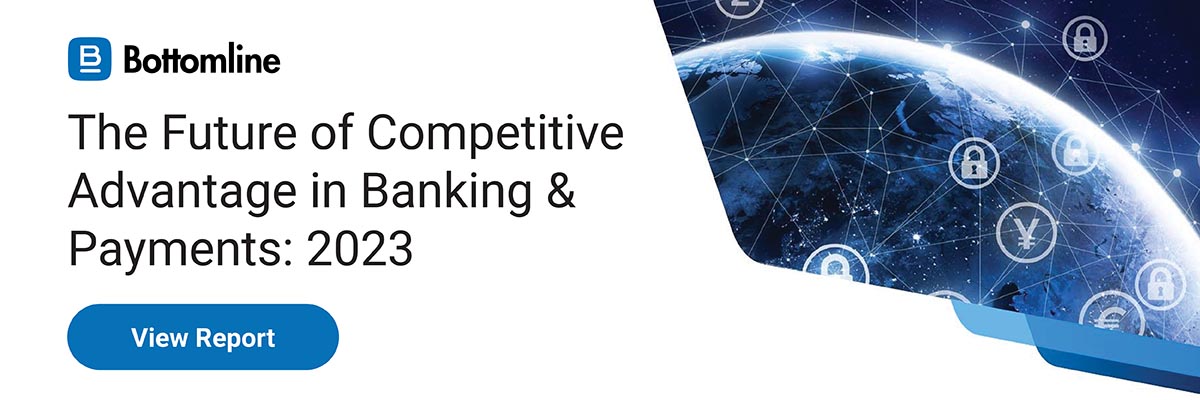As the Roman poet Ovid once said, ‘A horse never runs as fast as when it has other horses to catch and surpass.’ This metaphor aptly captures the essence of today’s banking sector, where understanding market demands and competitor strategies is crucial for staying ahead in the race. Competition not only drives the market but also serves as a catalyst for continuous innovation and growth within financial institutions.
Plus, there is no shortage of global issues for banks to put on their agenda for 2024. Right off the top, we have cloud migration, the acceleration of real-time or instant payments, new regulations, and fraud mitigation to contend with.
Those priorities were evident in this year’s global “Future of Competitive Advantage in Banking and Payments” report from fintech solutions provider Bottomline.
However, look under the surface of the key findings, and one can see something very interesting. What’s front of mind for banking executive in New York City might not meet the same priorities in London, Frankfurt, Zurich, or Singapore. Those differences are necessary to track as executives continue to craft their 2024 and future roadmaps.
Bottomline has identified three key findings in the report that are essential to understand as we enter the new year. They also highlight the different priorities and pain points across the regions globally covered.
Modernizing payments with digital and cloud strategies

Image by rawpixel.com on Freepik
This strategy should start with payments modernization. According to the report, there are some significant regional differences here.
First, when it comes to digital transformation, Bottomline surveyed over 600 global respondents to see if they were confident in their institution’s current digital payments transformation strategy.
The findings were that North America seems much more sceptical than other regions, with 39% choosing options “highly” or “somewhat” sceptical. Europe is the most bullish, with 78% feeling “highly” or “somewhat” confident.
That’s a big swing and could be attributed to the regulations coming down in the UK and Europe, most of which concern real-time/instant payments. If banks feel like their digital transformation roadmap is mandated, it’s entirely possible they feel more confident about achieving it).
The next question supports that theory, which centered around migrating to the cloud or, as it was phrased, “a single SaaS-based platform for your payments and messaging ecosystem.”
73% of APAC respondents have a “strong” or “extremely strong” appetite to transition to SaaS versus 60% globally and only 44% for NA. Again, does digital transformation equate to the cloud for many banking executives? Bottomline’s research suggests that it does.
Real-time payments picks up the pace

Image by Freepik
There’s arguably no more important issue globally for 2024. FedNow, an instant payment service developed by the Federal Reserve for depository institutions in the U.S., will see its first full year as a payment platform.
In the EU and EAA, the European Payments Council’s new mandate will be approved (November 2023 saw political agreement), which will mean all EU and EAA citizens need to be able to send and receive instant payments within six and 12 months respectively (EEA is 30 months and 36 months).
Therefore, financial institutions must get cracking and pick up the pace. Not only because adding a new payment rail in itself involves at least a 9-month project but also to ensure you achieve certain added requirements.
These include ensuring the new instant payment fees stay in line with non-instant transfers and that you have the functionality in place to match the international bank account number (IBAN) and the name of the beneficiary and can verify clients against the regularly-updated EU sanctions list.
Similarly, any bank in the Swiss market that processes 500,000+ SIC messages needs to be ready for SIC IP by Aug 2024 (the planning for SIC IP service corresponds to a ‘technical go live’ in November 2023 and a ‘market go live’ in August 2024). Testing should start no later than mid-2023 for early adopters and so yet another date for your strategic diaries) and all the remaining banks by 2026.
Additionally, Pay.UK is announcing changes to the New Payments Architecture, and UK Faster Payment’s role is increasing imminently.
Lastly, will P27 in the Nordics be on hold permanently, or will a new proposition be resurrected soon?
According to the Competitive Banking report, the message has been delivered. Real-time rails and mitigating fraud risk are the top two pain points everywhere except APAC, which focuses more on cross-border payments, as you would expect from a region with so many currencies.
Compliance and regulation are much more important in Europe than elsewhere globally in reaction to a plethora of new mandates for Confirmation of Payee, Instant Payments, and the UK’s New Payments Architecture expected update. It’s no surprise then that Europe is the most aware of how compliance and regulation will be more important over the next 12 months. North America tracked second, supporting our belief that the pace of change will not abate.
However, 94% of Europe respondents believe it will be “very” or “somewhat” challenging to remain compliant, well above the global combined view of 88%. Presumably, 11% of European respondents don’t think it will be difficult because they have already started following best practices and pre-empted the implementation in their roadmaps.
ISO 20022 messaging

It seems like all roads, at some point, intersect with ISO 20022 messaging format.
Digital transformation is necessary to reap all the benefits of ISO. ISO 20022 is the linchpin of real-time payments. The functionality and attributes that it adds also correlate with the key expectations that corporates have from their banks – connectivity to real-time rails, improved fraud mitigation and management tools, and access to real-time cash balance, and end-to-end visibility – all interlinked through faster payments, potential fraud, and 24/7/365 cash visibility.
When asked, “Which areas of your company’s cash positioning and fraud monitoring could benefit from the improved data that ISO 20022 provides?”. All regions agreed that improved fraud monitoring and management would reap the biggest benefits of moving from the basics ISO ‘connectivity-only’ to the more data-rich ‘market-ready’ and then through to the optimum status of ISO 20022 ‘native’.
Europe and North America emphasized reducing manual intervention and focusing on straight-through processing.
Looking ahead at 2024
Yes, 2024 will feature busy product roadmaps for financial institutions but expect it to be a year of driving innovation and developing best practices. Institutions can leverage ISO and SaaS to make things easier.
That said, organizations cannot roll out each solve in isolation. They are all interlinked from real-time, cross-border and domestic payments to liquidity management and visibility, fraud mitigation and new pre-validation compliance requirements.
As the report shows, the industry faces common issues with regional subtexts. It’s by addressing the common issues that progress will be made.
The financial institutions that pre-empt both customer and market demand, will drive innovation that surpasses their competitors, leading the herd and becoming the true payment heroes.
Read Bottomline’s “Future of Competitive Advantage in Banking and Payments” full report here.


Comments